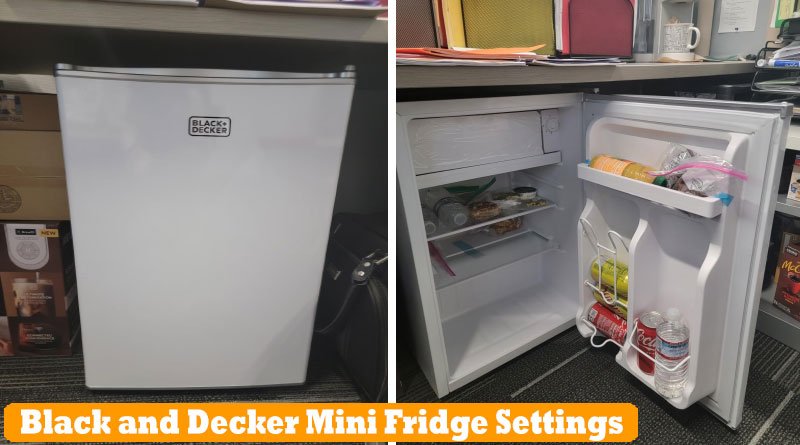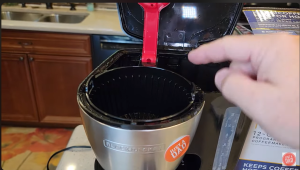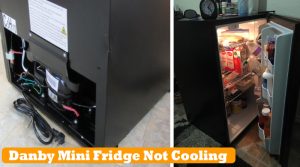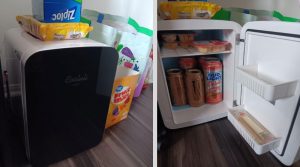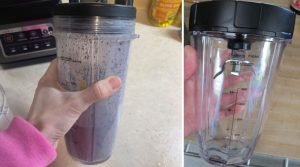Black and Decker Mini Fridge Settings: Setting Cold Standard
The art of adjusting Black and Decker mini fridge settings can turn that vision into daily reality. The Black and Decker mini fridge offers a compact and efficient cooling solution for various settings, whether a dorm room, office, or small living space. Packed with innovative features, this mini fridge is designed to meet the diverse needs of users while providing optimal temperature control. With a user-friendly interface, the appliance allows for easy adjustment of settings to customize cooling preferences.
Whether you need to chill beverages, store snacks, or keep perishables fresh, the Black and Decker mini fridge ensures convenience and reliability with its versatile settings. In this introductory paragraph, we’ll delve into the key attributes that make this appliance a go-to choice for those seeking a reliable and adaptable mini fridge experience.
Best Way For Black and Decker Mini Fridge Settings
When you welcome a Black and Decker mini fridge into your home, you claim a convenient and reliable cooling solution for your space, whether it’s your dorm room, tiny apartment, or compact home office. But to truly make the most out of this refrigerated gem, it’s essential to be well-versed in its settings—each of which can enhance experience in different ways.
If you’ve recently unpacked mini fridge and aren’t sure where to begin, or if you’ve had it for a while but haven’t ventured past the default settings, stay tuned. We’re about to delve into the top 5 settings that you should master to maximize the potential of Black and Decker mini fridge.
1. Temperature Control
Right off the bat, temperature control is king. Mini fridge has a dial that lets you adjust the internal temperature to suit your needs. But what should you set it at? The ideal refrigeration temperature for most foods and drinks is between 35 and 40 degrees Fahrenheit, which helps prevent spoilage and bacteria growth. Conversely, setting fridge too cold can result in items freezing, which may not be ideal for specific items like beverages that you want to keep at a consistently excellent, but not cold, temperature.
Setting Guide:
- Turn the dial to the right to decrease the temperature.
- Turn the dial to the left to increase the temperature.
Remember, it’s all about balance: storing food at the correct temperature is not just for quality but also for energy efficiency.
2. Energy-Saving Mode
Black and Decker’s mini-fridges often come with an energy-saving mode. This feature is more than just great for the environment; it also reduces energy bills. Energy-saving mode typically adjusts the power usage to the minimum required to maintain safe temperatures.
Activating Energy-Saving Mode:
- Check user manual to find where the energy-saving mode button or setting is located.
- Press the button or select the energy-saving mode on the internal display, which might show you a leaf or eco symbol.
Remember, efficiency doesn’t stop at the fridge’s settings; ensuring the door seals are clean and undamaged is essential to keep fridge running efficiently.
3. Defrosting Setting
Nobody likes a mini fridge that’s iced over. Ice buildup reduces the cooling efficiency and can take up valuable space that you’d instead use for groceries. This is where the defrost setting comes in handy.
Defrosting Guide:
- Begin by turning off mini fridge and removing all the contents.
- Place towels at the base of the refrigerator to catch the water as the ice melts.
- Leave the door open; this can speed up the process. Do not scrape the ice, as it can damage the appliance.
Once the ice has fully melted, dry the fridge’s interior, refresh the setting to preferred temperature, and reintroduce items.
4. Interior Lighting
Interior lighting might seem trivial, but it’s a game-changer in low-light conditions. Whether pulling a midnight snack in a shared dorm room or reaching for bottled water during a late-night study session, seeing what’s inside without needing a torch is undeniably helpful.
Utilizing Interior Lighting:
- Find the interior lighting switch (often a push-button near the door frame).
- Press the switch to turn on the light.
If mini fridge’s light is not working, check the user manual for troubleshooting steps, or consider replacing the light bulb, which is generally straightforward.
5. Door Alarm
The door alarm might be silent safeguard against spoilage. It ensures the door is not left ajar, which can lead to a spike in temperature, spoilage of food, and undue energy consumption.
Setting Up the Door Alarm:
- Consult your user manual to locate the controls for the door alarm (usually on the frame of the fridge door).
- Turn the door alarm setting to the ‘on’ position.
To verify it’s working, leave the door slightly ajar for a few seconds, and you should hear the alarm. Mastering these settings on Black and Decker mini fridge is like unlocking a new level of convenience and efficiency in everyday life. Each feature is designed to simplify your life and ensure food and beverages are in the best condition. Remember, fridge is a companion; treat it well, and with these tips, it will serve you faithfully for years.
Black and Decker Mini Fridge Temperature settings
One-size-fits-all does not apply to fridge settings. Here’s a helpful breakdown of how to adjust mini fridge for various needs:
Food Preservation in the Fridge Compartment
The FDA recommends keeping fridge at or below 40°F (4°C) for the storage of perishable food items to prevent bacterial growth. Here’s a quick guide on shelf-by-shelf settings:
- Top Shelf: It’s the coldest part; set it at 37-38°F for dairy and raw meats.
- Middle Shelf: Ideal for cooked leftovers and ready-to-eat foods at 38-40°F.
- Bottom Shelf: Set near 39-40°F for produce or any additional meat storage.
Chilling Beverages in the Freezer
If Black and Decker mini fridge has a freezer compartment, set it between 0-5°F (-18 to -15 °C). This will ensure your ice stays solid and beverages stay frosty without undue freezing.
Customized Cooling with the Thermostat
Temperature preferences vary; a room with high heat requires slightly lower fridge settings. The adjustable thermostat lets you fine-tune the temperature to liking while adhering to food safety standards.
Energy Efficiency Tips for Black and Decker Mini Fridge
An energy-efficient mini fridge might already be a significant step toward reducing carbon footprint and fostering a green home. But let’s not halt the energy-saving mission there. Here are a few tips to further bolster your appliance’s eco-cred:
Keep it Full But Not Overloaded.
A fridge works optimally when it’s not too sparse or too packed. The thermal mass of stored items helps maintain the desired temperature without fridge working overtime.
Regular Defrosting
If your model has a freezer compartment, regularly defrost it to prevent ice buildup, which can lead to increased energy consumption.
Maintain Airtight Seals
Inspect and clean the door gaskets regularly. A clean and undamaged gasket ensures a proper seal, preventing cool air from escaping and warm air from infiltrating.
Location
Place fridge away from heat sources like ovens or direct sunlight. This reduces the time the compressor needs to run to keep things cool.
Organizing Mini Fridge for Optimal Efficiency
The organization is the unsung hero of a well-performing fridge. Here are some organizing tips to maximize mini fridge’s utility:
- Use stackable containers and bins to make the most of vertical space.
- Keep like items together to quickly grab what you need without letting too much calm air escape.
- Label your shelves if you live with others to ensure everyone knows where things should go, reducing the chance of prolonged door-open times.
- Rotate stocks; place new items in the back and bring older ones forward to reduce waste from lost items in the fridge’s depths.
Maintenance and Cleaning: The Fridge’s Fountain of Youth
Regular maintenance is vital if you want your faithful mini fridge to last. Here’s a checklist:
- Defrost the freezer as needed or when ice is about a quarter of an inch thick.
- Wipe down the interior and exterior with a damp cloth and mild detergent, focusing on spills and sticky spots.
- Clean the condenser coils to ensure proper ventilation, and before cleaning, always unplug or shut off the power to the fridge.
- Remember the drip tray, if applicable! It can harbor odors and bacteria if not cleaned regularly.
Troubleshooting Common Issues of Mini Fridge
Even the best appliances can encounter hiccups. Let’s address common mini fridge issues and their solutions:
The fridge is Not Cold Enough
- Temperature should be set appropriately on the thermostat.
- Verify that the door is sealing correctly.
- If applicable, clear any obstructions in the internal vents.
Excessively Cold Freezer
- Adjust the thermostat slightly higher.
- Monitor the items in the freezer to ensure they are within the cooling element.
- Call a professional to check the insulation and seals if the issue persists.
Noisy Operation
A mini fridge can be louder than a standard fridge due to its size. However, if it becomes deafening, check for any items vibrating against the walls or compressor unit.
Leaking Water
A common cause is a clogged defrost drain. Locate the drain and clear it using a mix of warm water and mild dish soap.
Benefit of Black and Decker Mini Fridge settings
Before we delve into settings, let’s explore the appliance ready to preserve your perishables. Black and Decker’s mini-fridges are known for their compact design and robust cooling capabilities, ideal for small spaces without sacrificing storage potential. The following features set them apart:
Compact Convenience: Typically slim and designed to fit into tight spaces, they’re perfect for small apartments, garages, or bedrooms.
- Thermostat Control: Most models come equipped with a thermostat knob for manual temperature adjustments.
- Adjustable Shelves: Organize your cans, jars, and containers as you see fit with adjustable shelf positions or remove shelves entirely for more room.
- Interior Light: Some models even boast a convenient internal light for those late-night snack hunts.
- Energy Star Rating: Many Black and Decker mini-fridges are lauded for their energy efficiency, a crucial element in maintaining environmental and financial health.
Now that you’re familiar with the fundamentals let’s fine-tune these features and harness the potential of your appliance to the fullest.
Final Verdict
Black and Decker mini fridge settings is not just a number on a thermostat — it’s a balance of functionality, efficiency, and personalization that transforms it into a staple of your home life. So, take the time to familiarize yourself with its inner workings and enjoy the tranquility of a well-maintained, perfectly chilled mini oasis in home.
Remember, the ideal mini fridge is a beacon of comfort and efficiency in the modern home. By understanding its settings, organizing storage, and staying on top of maintenance, you can ensure it runs like a well-oiled machine for years.
FAQs Of Black And Decker Mini Fridge Settings
Q: What are the different settings on my Black and Decker mini fridge?
A: Most Black and Decker mini fridges have a temperature control dial ranging from 1 (the warmest) to 7 (the coldest).
Q: What is the recommended setting for my Black and Decker mini fridge?
A: The optimal setting can vary depending on needs and the external environment. However, a mid-range setting around 4 is often a good starting point.
Q: How can I adjust the temperature setting on my Black and Decker mini fridge?
A: Turn the temperature control dial to the desired setting. If adjusting the temperature significantly, allow at least 24 hours for the fridge to reach the new temperature.
Q: Why isn’t my Black and Decker mini fridge getting cold enough, even in the highest setting?
A: There could be several reasons, such as a blocked vent, a problem with the thermostat, or an issue with the compressor. Check these areas or consult with a professional if needed.
Q: Can I change the door swing direction on my Black and Decker mini fridge?
A: Yes! Most Black and Decker mini fridges have reversible doors. Refer to user manual for specific instructions on how to do this.

